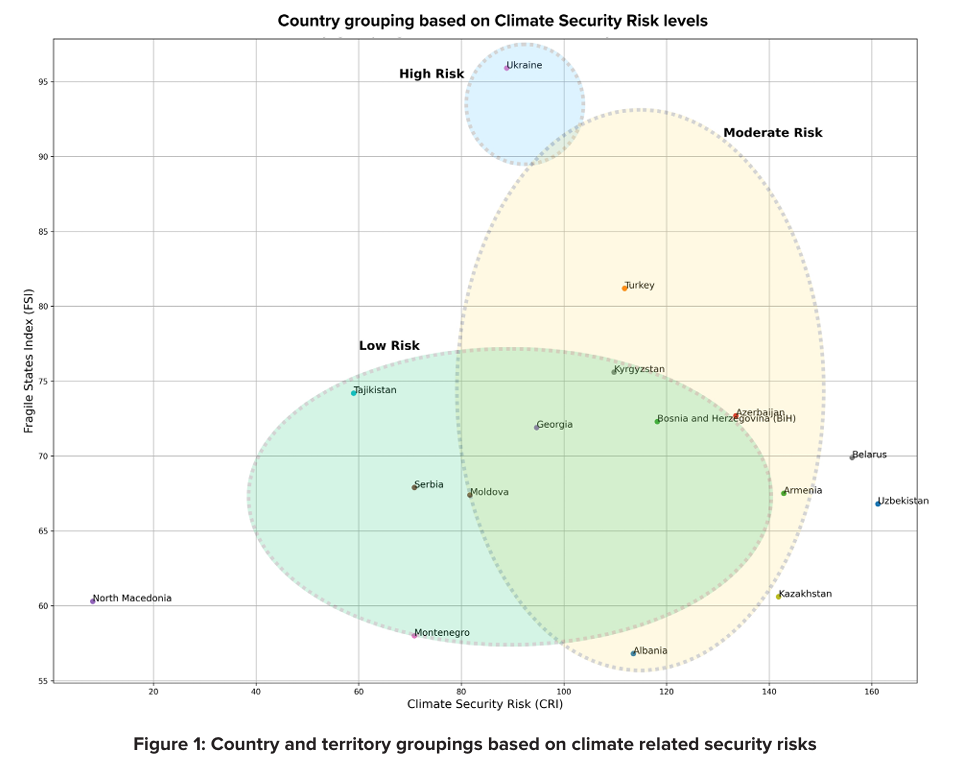Regional Policy Brief: Mapping and analysis of climate-related security risks in the second round of the Nationally Determined Contributions (NDCs) and National Adaptations Plans (NAPs) in Europe and Central Asia, published by United Nations Development Programme (UNDP) Europe and Central Asia, April 2025.
The policy brief provides an overview of climate-related security risks in Europe and Central Asia by examining how climate-related security risks have been addressed in the second round of Nationally Determined Contributions (NDCs), National Adaptation Plans (NAPs), and National Communications. The analysis focuses on both direct and indirect climate-related security risks as well as fragility and climate risk profiles of the countries and territories in the region.
The findings reveal that most countries and territories in the region face significant challenges, including increased fragility, conflict, heightened climate vulnerability, and recurrent drought. In addition, countries and territories in the region face varying levels of climate-related security risks, and these risks are not adequately integrated into their respective national climate policies and reports, including NDCs, NAPs, and National Communications.
Key Messages:
1. Fragility, climate vulnerability, and drought impact:
The Europe and Central Asia region is experiencing a convergence of climate risks (e.g., droughts, sea level rise) and socio-economic fragility, which could potentially develop into climate-related security risks. One of the most pressing threats is the increasing waves of drought, which are becoming more frequent and intense. Droughts threaten to exacerbate existing environmental and socio-economic fragilities, leading to heightened water scarcity, rapid land degradation, and accelerated glacier melting, mounting threats to social cohesion and stability in the region.
2. Geopolitical, water and food insecurity risks:
As droughts become more recurrent and intense, diminishing trends in rainfall and river flows increase geopolitical risks over shared natural resources. The profound impacts of drought on water and land resources could exacerbate food insecurity, potentially leading to food crises, migration, and social unrest. The significant impact of drought could also disrupt ambitious hydropower plans, as the region hosts some of the world’s pioneering hydropower projects, which could disturb energy security, destabilize social cohesion, and threaten socio-economic stability.
3. Direct and indirect climate-related security risks:
- Direct climate-related security risks (e.g., exacerbation of conflict, social tensions) are scarcely addressed in NDCs, NAPs, and National Communications. Only a few countries, such as Republic of Moldova and Georgia, explicitly reference these risks.
- Indirect risks to human security are more commonly mentioned, such as impacts on food security, economic stability, and energy security, but the linkages to security are generally underreported or not analysed in detail.
- Azerbaijan, Bosnia and Herzegovina, Republic of Moldova and Serbia highlight indirect climate related security risks, such as resource competition, economic instability, and social tensions, exacerbated by vulnerabilities in agriculture, water resources, and energy sectors. However, explicit discussions linking climate change to national security remain limited in these countries’ NAPs and NDCs.
4. Regional fragility and climate risk:
The region is classified as “medium” in terms of fragility, with countries like Kyrgyzstan, Tajikistan, and Türkiye at or near the threshold of “high” fragility. Tajikistan also ranks high in terms of climate risk. The combination of high fragility and climate risk points to the urgent need for integrated approaches to address climate-related security risks and ensure that climate actions also contribute to sustaining peace and stability.
5. Countries and territories by levels of climate-related security risks:
Figure 1 visualizes the grouping of countries based on their climate-related security risk levels, taking into account their vulnerability to climate risks (CRI scores) and fragility (FSI scores). The countries are categorized into three groups: Low (green), Moderate (yellow), and High (blue) risk levels, each indicated by coloured dashed ellipses. The positions of the countries on the chart illustrate the relationship between their climate vulnerability and fragility, with those in the upper right quadrants showing higher fragility and vulnerability scores. The grouping effectively highlights which countries face greater climate-related security risks, enabling stakeholders to identify regions requiring more urgent interventions and resilience-building efforts.

Recommendations:
Policy recommendations include conducting multi-country and territorial climate-related security risk assessments, developing integrated climate resilience plans, strengthening institutional and regional partnerships, providing policy and program advisory support, and incorporating climate-related security risks into NDCs, NAPs, and sectoral plans.
These are extracts from a policy brief published by United Nations Development Programme (UNDP) Europe and Central Asia, April 2025. To read the full paper, follow the link here.
See below for our coverage on similar topics:
- UN Peacebuilding Fund Tip Sheet on Climate, Peace and Security and Environmental Peacebuilding
- The Caspian Sea Region: a renewable hub for European energy security?
- The Impact of Climate Change on Conflict
Photo by Igor Sporynin on Unsplash



